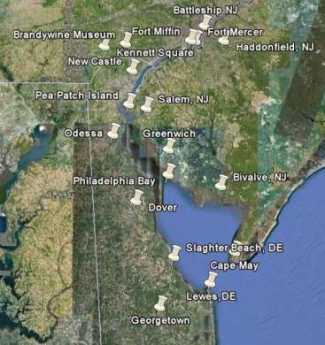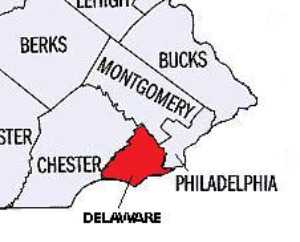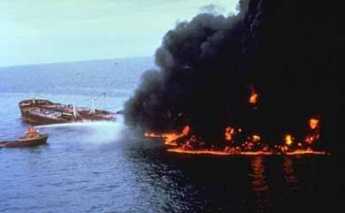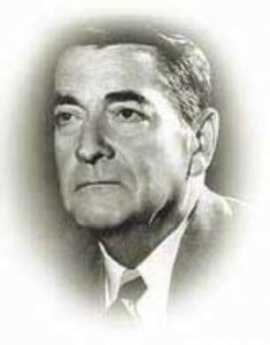Related Topics
Philadelphia Legal Scene
The American legal profession grew up in this town, creating institutions and traditions that set the style for everyone else. Boston, New York and Washington have lots of influential lawyers, but Philadelphia shapes the legal profession.
Nature Preservation
Nature preservation and nature destruction are different parts of an eternal process.
Land Tour Around Delaware Bay
 Start in Philadelphia, take two days to tour around Delaware Bay. Down the New Jersey side to Cape May, ferry over to Lewes, tour up to Dover and New Castle, visit Winterthur, Longwood Gardens, Brandywine Battlefield and art museum, then back to Philadelphia. Try it!
Start in Philadelphia, take two days to tour around Delaware Bay. Down the New Jersey side to Cape May, ferry over to Lewes, tour up to Dover and New Castle, visit Winterthur, Longwood Gardens, Brandywine Battlefield and art museum, then back to Philadelphia. Try it!
Right Angle Club 2008
A report, to the year 2008 shareholders of the Right Angle Club of Philadelphia, by the outgoing president, Neale Bringhurst...
Delaware County, Pennsylvania
.
The Corinthos Disaster

|
|
Oil Tanker on Fire
|
Fire, huge fire. The Corinthos disaster of January 30, 1975, was the biggest fire in Philadelphia history, and one hopes the biggest forevermore. Its immensity has possibly lessened attention for some associated issues which are nevertheless quite important, too. Like the issue of punitive damages in a lawsuit, or the need to balance environmental damage with a national need for energy independence. And the changing ways that law firms charge their clients. We hope the relatives of the victims will not be offended if the tragedy is used to illustrate these other important issues.
On that cold winter day, two big tanker ships were tied up alongside the opposite banks of the Delaware River at Marcus Hook. The Corinthos was a 754-foot tanker with a capacity of 400,000 barrels of crude oil, tied up on the Pennsylvania side at the British Petroleum dock with perhaps 300,000 barrels still in its tanks at the time of the disaster. At the same time, the 660-foot tanker Edgar M. Queen

|
|
Edgar M. Queeny
|
with roughly 250,000 barrels of specialty chemicals in its hold, let go its moorings to the Monsanto Chemical dock directly across the river in New Jersey, intending to turn around and head upstream to discharge the rest of its cargo at the Mantua Creek Terminal near Paulsboro. Curiously, a tanker is more likely to explode when it is half empty because there is more opportunity for mixing oxygen with the combustible liquid sloshing around. A tug stood by to assist the turn, but the master of the Queeny felt there was ample room to make the turn under her own power. With no one paying particular attention to this routine maneuver, the Queeny seemed (to only casual observers) to head directly across the river, ramming straight into the side of the Corinthos. Actually, the Queeny had engaged in a number of backing and filling maneuvers, and the sailors aboard were appalled that it seemed to lack enough backing power to stop its headlong lunge at the Corinthos. There was an almost immediate explosion on the Corinthos, and luckily the Queeny broke free with only its bow badly damaged. Otherwise, the fire might have been twice as large as it proved to be with only the Corinthos burning. The explosion and fire killed twenty-five sailors and dockworkers, burned for days, devastated the neighborhood and occupied the efforts of three dozen fire companies. A graphic account of the fire and fire fighting was written by none other than Curt Weldon who was later to become Congressman from the district, but was then a volunteer fireman active in the Corinthos tragedy.
There were surprising water shortages in this fire on the river because the falling tides would take the water's edge too far away from the suction devices for the fire hoses on the shore. The tide would also rise above a gash in the side of the burning ship, floating water in and then oil up to the point where it would flow out of the ship onto the surface of the river. Oil floated two miles upstream from the burning ship and ignited a U.S. Navy destroyer which was tied up at that point. Observers in airplanes estimated the oil spill was eventually fifty miles long. All of these factors played a role in the decision whether to try to put the fire out at the dock or let it burn out; experts continue to argue which would have been better. There were always dangers the burning ship would break loose and float in unexpected directions, that the oil slick would ignite for its full length, and that storage tanks on shore would be ignited. The initial explosion had blown huge pieces of iron half a mile away, and the ground near the ship was littered with charred, dismembered pieces of flesh from the victims.
, Of course, there was a big lawsuit. When a ship is tied up at a dock it certainly feels aggrieved when another ship crosses a river and rams it. The time-honored principle of admiralty law holds that the owner of an offending ship is not liable for damages greater than the salvage value of its own hulk, which in this case might have been about $3 million. The underlying assumption is that the owner has no way of knowing what is going on thousands of miles away, no control over it, no power to respond in a useful way. Enter Richard Palmer, counsel for the Corinthos. Palmer was aware that the National Transportation Safety Board collects information about ship maintenance inspections in order to share useful information for the benefit of everyone. His inquiry revealed that the inspections of the Queeny for four years before the crash had repeatedly demonstrated that the stern engine had a damaged turbine, and was only able to drive the ship at 50% of its rated power. Why this turbine had not been repaired was now irrelevant; the owners of the ship did have relevant information and had failed to act in a timely safe fashion. The limitation of liability to the salvage value of the hulk now no longer applied if the negligence was judged relevant. The defendants, the owners of the Queeny, decided to settle. While the size of the settlement is a secret of the court, it is fair to guess that it approached the full value of the suit, which was $11 million. Mr. Palmer, by using his experience to surmise that maintenance records might be available at the Transportation Agency, and recognizing that the awareness of the owner might switch the basis for the compensation award from hulk value (of the defendant's ship) to the extent of the damage (to the plaintiff's ship), probably tripled the damage settlement.
Reflections on the extraordinary benefit to the client from a comparatively short period of work by the lawyer leads to a discussion about the proper basis for lawyers fees. Senior lawyers feel that the computer has revolutionized lawyer billing practices, and not for the better. Because it is now possible to produce itemized billing which summarizes conversations of less than a minute in duration, services for the settlement of estates can be many pages long, mostly for rather routine business. Matrimonial lawyers are entitled to charge for hours of listening to inconsequential recriminations; lawyers can bill for hours of time spent reading documents into a recording machine, or sitting wordlessly at depositions. Since the time expended can now be flawlessly measured and recorded on computers, there is little room for a client to remonstrate about their fairness. Discomfort about this system underlies much sympathy for billing for contingent fees, where the lawyer is gambling all of his expenses and effort against a generous proportion of the award if he wins the case, nothing at all if he loses. This latter system, customary in slip and fall cases and justified as permitting the poor client to have proper representation, undoubtedly promotes questionable class action suits and often leads to accepting personal liability suits which should be rejected for lack of merit. The thinking underlying personal injury firms is widely said to be: most insurance companies will settle for modest awards in cases without merit because the defense costs would be no less than that amount, and occasionally a personal liability case gets lucky and extracts a huge award.
Listen to one old-time lawyer describe how legal billing used to be. After the case was over, the lawyer and the client sat down to a discussion of what was involved in the legal work, and what it accomplished for the client. A winning case has more evident value than a losing one, provided the lawyer can effectively describe the professional skills that helped bring it about. The whole discussion is aimed at having both parties leave the discussion satisfied. To the extent that both parties actually are satisfied with the value of the services, the esteem and reputation of the legal profession are enhanced. And the lawyer is a happy and contented member of a grateful community. If he can occasionally claim a staggering fee for a brief but brilliant performance, as in the case of the explosive fire on the Corinthos -- well, more power to him.
It does not take much familiarity with oil refineries to make you realize that cargoes of crude oil are a very dangerous business. We are accustomed to hearing jeers at those who protest, "Not in my backyard", and we deplore those who would jeopardize our national security to protect a few fish and trees in the neighborhood of potential oil spills. Since we do have to import oil and we do therefore have to jeopardize a few selected neighborhoods to accomplish this vital service, the opponents are sadly destined to lose their protests. But that doesn't mean their concerns are trivial. The shipping and refining of oil are dangerous. We just have to live with it and be ready to pay for its associated costs.
Originally published: Sunday, July 20, 2008; most-recently modified: Thursday, June 06, 2019
| Posted by: Frederick Perez PE | May 30, 2018 7:33 PM |
| Posted by: Bob Reynolds | Apr 27, 2017 1:16 AM |
| Posted by: JOE DUBOLINO | Dec 11, 2016 3:09 PM |
| Posted by: Dave | Aug 4, 2016 2:31 PM |
| Posted by: Gerard | Oct 6, 2014 7:08 PM |
| Posted by: bgboulden | Nov 7, 2013 12:54 AM |
| Posted by: Ron Menna | Sep 4, 2013 12:33 AM |
| Posted by: Bill A | Jul 8, 2013 4:04 PM |
| Posted by: RTB | May 8, 2013 11:47 PM |
| Posted by: Earl E. Maxfield, Jr. | May 1, 2013 9:31 PM |
| Posted by: Stephanie | Apr 26, 2013 9:16 PM |
| Posted by: GWC | Apr 9, 2012 12:05 AM |
| Posted by: Maureen | Mar 23, 2012 10:30 PM |
| Posted by: P. C. Stowe | Feb 7, 2012 9:00 AM |
| Posted by: Richard Heacock Jr | Jan 7, 2012 6:27 PM |
| Posted by: David Van Stan | Sep 12, 2011 9:32 AM |
| Posted by: Don Lewis Jr. | Aug 22, 2011 5:55 PM |
| Posted by: [none] | Apr 22, 2011 2:07 PM |
| Posted by: bill franzen | Apr 19, 2010 8:29 AM |
| Posted by: ryan johnson | Mar 18, 2010 2:21 PM |
| Posted by: [none] | Mar 17, 2010 4:53 PM |
| Posted by: [none] | Dec 16, 2009 6:47 AM |
| Posted by: WRS | Aug 31, 2009 11:34 AM |
 Start in Philadelphia, take two days to tour around Delaware Bay. Down the New Jersey side to Cape May, ferry over to Lewes, tour up to Dover and New Castle, visit Winterthur, Longwood Gardens, Brandywine Battlefield and art museum, then back to Philadelphia. Try it!
Start in Philadelphia, take two days to tour around Delaware Bay. Down the New Jersey side to Cape May, ferry over to Lewes, tour up to Dover and New Castle, visit Winterthur, Longwood Gardens, Brandywine Battlefield and art museum, then back to Philadelphia. Try it!

